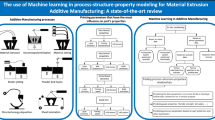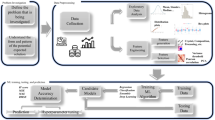Abstract
Additive manufacturing (AM), also known as 3D printing, has revolutionized the industrial sector by enabling the production of intricate geometries and specialized parts. However, achieving optimal surface finish and mechanical properties in AM poses challenges due to factors like material properties and machine characteristics. Accurately predicting surface finish is essential for process optimization and minimizing post-processing efforts. This abstract presents an innovative approach to predict surface finish and tensile strength simultaneously in AM. Leveraging advanced machine learning techniques, predictive models are developed using a comprehensive dataset of process parameters and corresponding measurements. The dataset is generated through systematic experimentation in the fused deposition modelling method, focusing on printing speed, layer thickness, and infill density. These models offer significant benefits to the industry, allowing manufacturers to optimize process parameters for desired surface finish and mechanical properties concurrently. By reducing reliance on trial-and-error approaches, they enhance efficiency, productivity, and part quality while lowering costs and accelerating product development cycles.








Similar content being viewed by others
Data availability
The authors confirm that the data supporting the findings of this study are available within the article.
References
Ngo, T.D., Kashani, A., Imbalzano, G., Nguyen, K.T.Q., Hui, D.: Additive manufacturing (3D Printing): A review of materials, methods, applications and challenges. Compos. Part B Eng. 143, 172–196 (2018). https://doi.org/10.1016/j.compositesb.2018.02.012
Sanei, S.H.R., Popescu, D.: 3D-printed carbon fiber reinforced polymer composites: a systematic review. J. Compos. Sci. 4, 98 (2020). https://doi.org/10.3390/jcs4030098
Dey, A., Yodo, N.: A systematic survey of FDM process parameter optimization and their influence on part characteristics. J. Manuf. Mater. Process. 3(3), 64 (2019). https://doi.org/10.3390/jmmp3030064
Donate, R., Paz, R., Quintana, Á., Bordón, P., Monzón, M.: Calcium carbonate coating of 3D-printed PLA scaffolds intended for biomedical applications. Polymers 15, 2506 (2023). https://doi.org/10.3390/polym15112506
Parmiggiani, A., Prato, M., Pizzorni, M.: Effect of the fiber orientation on the tensile and flexural behaviour of continuous carbon fiber composites made via fused filament fabrication. Int. J. Adv. Manuf. Technol. 114, 2085–2101 (2021). https://doi.org/10.1007/s00170-021-06997-5
RajendranRoyan, N.R., Leong, J.S., Chan, W.N., Tan, J.R., Shamsuddin, Z.S.B.: Current state and challenges of natural fibre-reinforced polymer composites as feeded in FDM-based 3D printing. Polymers 13, 2289 (2021). https://doi.org/10.3390/polym13142289
Lee, C.H., Padzil, F.N.B.M., Lee, S.H., Ainun, Z.M.A.A., Abdullah, L.C.: Potential for natural fiber reinforcement in PLA polymer filaments for fused deposition modeling (FDM) additive manufacturing: a review. Polymers 13, 1407 (2021). https://doi.org/10.3390/polym13091407
Yadav, D., Chhabra, D., Garg, R.K., Ahlawat, A., Phogat, A.: Optimization of FDM 3D printing process for multi-material using artificial neural network. Mater. Today Proc. 21(3), 583–1591 (2020). https://doi.org/10.1016/j.matpr.2019.11.225
Heidari-Rarani, M., Ezati, N., Sadeghi, P., Badrossamay, M.R.: Optimization of FDM process parameters for tensile properties of polylactic acid specimens using Taguchi design of experiment method. J. Thermoplast. Compos. Mater.Thermoplast. Compos. Mater. 35, 12 (2020). https://doi.org/10.1177/0892705720964560
Chohan, J.S., Kumar, R., Yadav, A., Chauhan, P., Singh, S., Sharma, S., Li, C., Dwivedi, S.P., Rajkumar, S.: Optimization of FDM printing process parameters on surface finish, thickness, and outer dimension with ABS polymer specimens using Taguchi orthogonal array and genetic algorithms. Math. Probl. Eng.Probl. Eng. (2022). https://doi.org/10.1155/2022/2698845
Steege, T., Bernard, G., Darm, P., Kunze, T., Lasagni, A.F.: Prediction of surface roughness in functional laser surface texturing utilizing machine learning. Photonics 10, 361 (2023). https://doi.org/10.3390/photonics10040361
Rajesh, A.S., Prabhuswamy, M.S., RudraNaik, M.: Machine learning approach: prediction of surface roughness in dry turning inconel 625. Adv. Mater. Sci. Eng. 2022, 6038804 (2022). https://doi.org/10.1155/2022/6038804
Elangovan, M., Sakthivel, N.R., Saravanamurugan, S., Binoy, B., Nair, V.S.: Machine learning approach to the prediction of surface roughness using statistical features of vibration signal acquired in turning. Procedia Comput. Sci. 50, 282–288 (2015)
Burke, C., Dalal, A., Abukhalaf, A., Noorani, R.: Effects of process parameter variation on the surface roughness of polylactic acid (PLA) materials using design of experiments (DOE). IOP Conf. Ser. Mater. Sci. Eng. 897, 012003 (2020). https://doi.org/10.1088/1757-899X/897/1/012003
Dandgawhal, A., Shukla, A., Ranade, C., Sabnis, S., Tarfe, M.: Experimental studies on effect of layer thickness on surface finish using FDM. Int. Res. J. Eng. Technol. 9(6), 181–188 (2022)
Kovan, V., Tezel, T., Topal, E.S., Camurlu, H.E.: Printing parameters effect on surface characteristics of 3D printed PLA materials. Int. Sci. J. Mach. Technol. Mater. 12(7), 266–269 (2018)
Qavi, A., Rahim, M.R.U.: A review on effect of process parameters on FDM-based 3D printed PLA materials. Int. Res. J. Mod. Eng. Technol. Sci. 4(6), 3088–3100 (2022)
Ramesh, M., Sundararaman, K.A., Sabareeswaran, M., et al.: Development of hybrid artificial neural network–particle swarm optimization model and comparison of genetic and particle swarm algorithms for optimization of machining fixture layout. Int. J. Precis. Eng. Manuf. 23, 1411–1430 (2022)
Sanaei, N., Fatemi, A.: Analysis of the effect of surface roughness on fatigue performance of powder bed fusion additive manufactured metals. Theor. Appl. Fract. Mech.. Appl. Fract. Mech. 108, 102638 (2020)
Abeykoon, C., Sri-Amphorn, P., Fernando, A.: Optimization of fused deposition modeling parameters for improved PLA and ABS 3D printed structures. Int. J. Lightweight Mater. Manuf. 3, 284–297 (2020)
Sun, C., Wang, Y., McMurtrey, M.D., et al.: Additive manufacturing for energy: a review. Appl. Energy 282, 116041 (2021)
Funding
The authors declare that no funding is received for this investigation.
Author information
Authors and Affiliations
Contributions
All the authors have contributed to the concept, experiment, testing, analysis, and manuscript writing.
Corresponding author
Ethics declarations
Conflict of interest
The authors declare that they have no known competing financial interests or personal relationships that could have appeared to influence the work reported in this paper.
Additional information
Publisher's Note
Springer Nature remains neutral with regard to jurisdictional claims in published maps and institutional affiliations.
Rights and permissions
Springer Nature or its licensor (e.g. a society or other partner) holds exclusive rights to this article under a publishing agreement with the author(s) or other rightsholder(s); author self-archiving of the accepted manuscript version of this article is solely governed by the terms of such publishing agreement and applicable law.
About this article
Cite this article
Selvan, S.P., Raja, D.E., Muthukumar, V. et al. Optimization of process parameters and predicting surface finish of PLA in additive manufacturing—a neural network approach. Int J Interact Des Manuf (2024). https://doi.org/10.1007/s12008-024-01848-5
Received:
Accepted:
Published:
DOI: https://doi.org/10.1007/s12008-024-01848-5




